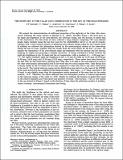Por favor, use este identificador para citar o enlazar a este item:
http://hdl.handle.net/10261/10777COMPARTIR / EXPORTAR:
 SHARE SHARE
 CORE
BASE CORE
BASE
|
|
| Visualizar otros formatos: MARC | Dublin Core | RDF | ORE | MODS | METS | DIDL | DATACITE | |

| Título: | The Night Sky at the Calar Alto Observatory II: The Sky at the Near-infrared |
Autor: | Sánchez, Sebastián F. CSIC ORCID; Aceituno, Jesús; Thiele, Ulrich; Cristóbal-Hornillos, David CSIC; Perea, Jaime CSIC ORCID; Alves, João | Palabras clave: | Calar Alto observatory Astronomical Phenomena and Seeing Near-infrared Fraction of useful time |
Fecha de publicación: | nov-2008 | Editor: | American Astronomical Society Astronomical Society of the Pacific University of Chicago Press |
Citación: | Publications of the Astronomical Society of the Pacific 120(873): 1244-1254 (2008) | Resumen: | We present the characterization of additional properties of the night sky at the Calar Alto observatory, following the study started by Sánchez et al. in 2007. We focus here on the night-sky brightness at the near-infrared, the telescope seeing, and the fraction of useful time at the observatory. For this study we have collected a large data set comprising 7311 near-infrared images taken regularly along the last four years for the ALHAMBRA survey (J, H, and Ks bands), together with a more reduced data set of additional near-infrared images taken for the current study. In addition, we collected the information derived by the meteorological station at the observatory during the last 10 yrs, together with the results from the cloud sensor for the last ~2 yr. We analyze the dependency of the near-infrared night-sky brightness with the air mass and the seasons, studying its origins and proposing a zenithal correction. A strong correlation is found between the night-sky brightness in the Ks band and the air temperature, with a gradient of ~ -0.08 mag per 1°C. The typical (darkest) night-sky brightness in the J, H, and Ks-band are 15.95 mag (16.95 mag), 13.99 mag (14.98 mag), and 12.39 mag (13.55 mag), respectively. These values have been derived for the first time for this observatory, showing that Calar Alto is as dark in the near-infrared as most of the other astronomical sites in the world with which we could compare it. Only Mauna Kea is clearly darker in the Ks band, but not only compared to Calar Alto but to any other observatory in the world. The typical telescope seeing and its distribution were derived on the basis of the FWHM of the stars detected in the considered near-infrared images. This value, ~1.0" when converted to the V band, is only slightly larger than the atmospheric seeing measured at the same time by the seeing monitor, ~0.9". Therefore, the effects different from the atmosphere produce a reduced degradation on the telescope seeing, of the order of ~10%. Finally we estimate the fraction of useful time based on the relative humidity, gust wind speed, and presence of clouds. This fraction, ~72%, is very similar to the one derived in 2007, based on the fraction of time when the extinction monitor is working. | Descripción: | 11 pages, 6 figures, 4 tables.-- ArXiv pre-print available at: http://arxiv.org/abs/0809.4988 | Versión del editor: | http://dx.doi.org/10.1086/593981 | URI: | http://hdl.handle.net/10261/10777 | DOI: | 10.1086/593981 | ISSN: | 0004-6280 |
| Aparece en las colecciones: | (IAA) Artículos |
Ficheros en este ítem:
| Fichero | Descripción | Tamaño | Formato | |
|---|---|---|---|---|
| 0809.4988v1.pdf | 749,55 kB | Adobe PDF |  Visualizar/Abrir |
CORE Recommender
SCOPUSTM
Citations
25
checked on 20-abr-2024
WEB OF SCIENCETM
Citations
19
checked on 29-feb-2024
Page view(s)
405
checked on 23-abr-2024
Download(s)
239
checked on 23-abr-2024
Google ScholarTM
Check
Altmetric
Altmetric
NOTA: Los ítems de Digital.CSIC están protegidos por copyright, con todos los derechos reservados, a menos que se indique lo contrario.
